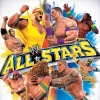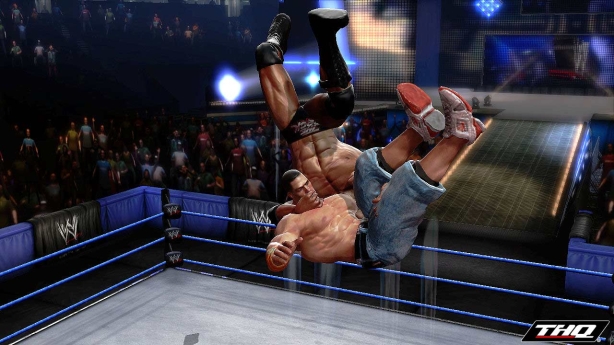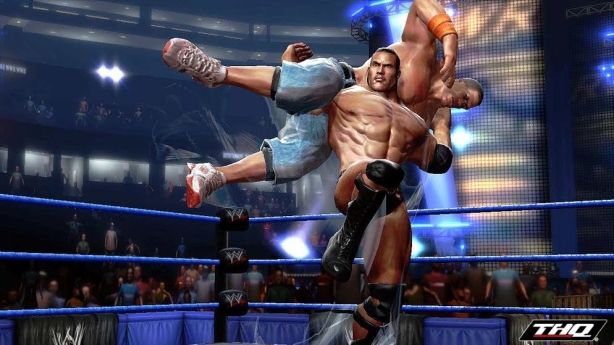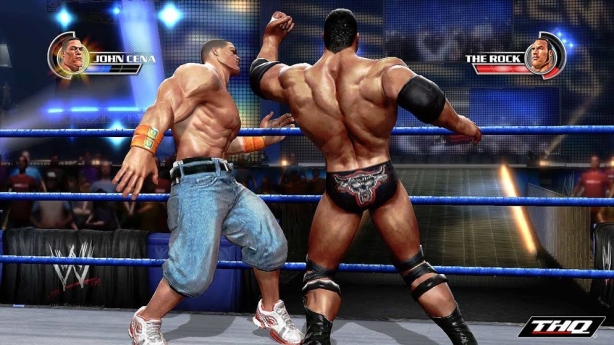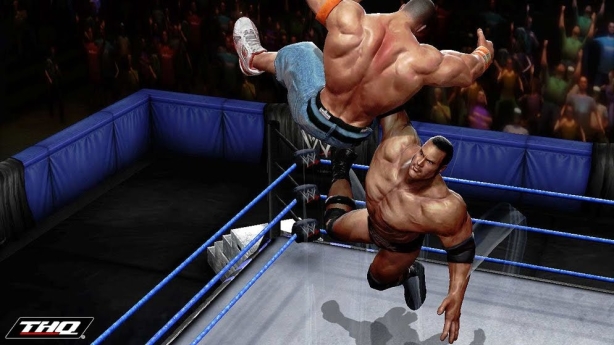WWE All Stars Review
Developer: THQ San Diego
Publisher: THQ
Available On: Xbox 360, Wii, PlayStation 3, PlayStation 2, PSP (Xbox 360 Version Reviewed)
The organisation formerly known as the World Wrestling Federation is currently at a relatively low ebb. With a roster made up largely of rookies and rising superstars, the company has been stripped of many of its big names through injury, personal demons, and retirement. The megastars who were once household names have moved on to become Mixed Martial Artists or Film Stars.
With their core franchise Smackdown Vs. Raw receiving the almost obligatory annual update, but not really moving the series forward, THQ wisely realised something needed to be done to win back their once loyal Wrestling game fanbase. What better then, than to turn to those departed heroes? The grapplers who once drew massive crowds to arenas around the world could surely recapture the hearts of fans.
STORY: WWE All Stars tries to bridge the gap between the current World Wrestling Entertainment product and that of the old WWF. What would happen if the idols of days gone by were put in dream matches with the new blood of today? You are about to witness the ultimate clash of the past versus the present of the wrestling world. Featuring a good mix of eighties legends, nineties megastars and the superstars of the present day, the game covers all of its bases so you are bound to find a fighter you are happy to play as in their selection. There is a pseudo career mode, but we’ll come to that later.
GRAPHICS: The game is unusual looking. The Smackdown Versus Raw series has become widely known for its authenticity and accuracy in striving to recreate the television experience of WWE, down to the smallest detail. Wrestlers and personalities have been honed and perfected until they look as close as possible to the real person, arenas are built piece-by-piece to resemble the real structure exactly. Even the presentation and menu heads-up display are designed to blend in with the TV-style feel as well as possible. WWE All Stars however, goes a very different route.
All Stars certainly goes for the less-is-more approach and straightaway users will see the simple, non-flashy menu systems. Move into a match and you are presented with the arena, a fair representation, but lacking a lot of the bells and whistles fans have become accustomed to, and the crowd looks worse than ever. As a superstar comes down to the ring, their entrance packages are vastly reduced. Instead of large scale, long, effects driven affairs, these are 10 second snatches of footage. Fireworks and lighting effects are played down, their music only plays briefly, and text in on-screen displays is simply plain. This is obviously not looking to compete with Smackdown in terms of accuracy.
Then we move onto the character models and animations. This is what has stood out about the game in previews, the caricature style. Every character (and I mean everyone) is turned into hulking, muscle-bound behemoths. Even the most pumped wrestlers are bloated further in order to become a cartoon version of their normal self. Costumes are actually very accurate, but when you take a look at the faces, it is often hard to tell who is who. So exaggerated are the faces, that some go beyond being caricatures and pass into the realms of being unrecognisable. This is unfortunate, but sometimes they are made so grotesque that the likeness is lost. Only their outfit gives the game away as to who we are looking at.
This isn’t true of all characters of course. The Undertaker and his manager Paul Bearer are both terrific. Paul Bearer in particular is spot on, down to his wobbling triple-chin and sleep deprived bags under his eyes. The Ultimate Warrior and Macho Man Randy Savage are other standouts, but they too are balanced by the poor likenesses of Rowdy Roddy Piper and even Shawn Michaels. It is a good idea to create these caricatures, in order to match the over-the-top action, but there must be some consistency in making them lifelike.
The animation again is very exaggerated, but this perfectly suits the game. Basic moves and strikes are fairly realistic looking, perhaps with a few concessions made where the laws of physics are relaxed, but move into the realm over aerial attacks, signature moves and finishers, and the science books are thrown straight out of the window. As competitors leap across the entire ring, or fling their enemy 20 feet into the air, the game takes a turn for the deranged, but the world of wrestling has always been in-your-face, so this insane action actually fits the genre well. THQ wanted to create a game where the unpredictable, extreme action of WWE was represented and in the respect of animation, it certainly succeeds.
SOUND: Due to the scaling back of extraneous elements, the sound isn’t as impressive as in other WWE games, but there is still extensive use of theme music and even voice-overs. Commentary is, as always, lacking somewhat. The same phrases are repeated quite frequently, and often the two commentators will speak over one another, sometimes about completely different subjects! This does tend to be irritating, but usually won’t distract from the action in the ring.
Wrestler voice-overs are implemented for the story based portions of the Path of Champions mode. Featuring full promo work from The Undertaker and Paul Bearer, Randy Orton and D-Generation X, these sections make the game a lot more enjoyable. Presented like backstage interview segments, their performances add to the retro feel, with wrestlers calling one another out and talking trash. They help to add a little spice to the rather uninspiring championship mode.
On top of that, the theme tunes used for wrestler entrances and victories are of a good quality, despite the short time we are treated to them. They are all 100% authentic and correct. The in-game sound effects such as booms and smashes when moves are executed are crazy, as would be expected. One could be forgiven for thinking a bomb had gone off, rather than a powerbomb executed, but the effects do help promote the feeling that these moves are really hard hitting and that the action is brutal. Accentuated by occasional screams and yells of pain, the action does feel more arcade-like, even down to the fact that all the screams are identical, like all good arcade action titles.
GAMEPLAY: The gameplay itself is akin to that of Smackdown, but simplified and cut-down. The four main action buttons are assigned to strike, strong strike, grapple and strong grapple. When in a grapple, each button will pull off one further grapple move. Strong strike and grapple can also be held for even stronger attacks. These controls, coupled with the shoulder buttons being used for blocks, reversals and interacting with the environment, are fairly standard and have been used in wrestling games since the PlayStation 2 days. The reversal system works well and even allows users to counter special moves, (which a lot of wrestling games don’t allow) but perhaps the system is too easy. A prompt will appear on-screen telling users when to reverse, so it is relatively easy to know when to time reversals. This can mean that people will reverse one another over and over, which begins to look a little silly.
Running and flying attacks can also be executed, although with a strange twist! Because the laws of physics are somewhat bent in the game, wrestlers can leap all the way across the screen when on a turnbuckle and will almost never miss a flying attack. Okay, the game is unrealistic in general, but this is just an annoying feature that pushes the bounds of realism a bit too far. Also, when players are hit, they tend to be hurled in the air. This results in bouncing and combo juggling that can compete with the Tekken series in terms of keeping an opponent in mid-air for an extended period of time. This does make the game seem a lot more like an arcade fighter than a normal wrestling title.
The problems come when you realise that there aren’t that many moves available to each wrestler. In Smackdown, (for example) when in a grapple, pressing a button would produce one move. Pressing the same button and any of the four directions would result in one of four other moves. So at least five grapple moves are assigned to each button. In WWE All Stars, each button controls one grapple move. That shows you the difference in the size of movesets, and you will find yourself repeatedly performing the same moves, which will become an irritant. Something that makes performing all of your moves difficult is the fact that no matter how devastating a move you pull off, your opponent never stays down on the mat for very long. This makes executing submission holds and ground attacks very hard, and being able to hit a downed enemy with a flying splash attack is almost impossible as they just stand back up too quickly.
Also, another addition that makes the game seem more like an arcade fighting title is the inclusion of knockouts. Wearing the energy bar of an enemy down completely before executing your finishing move will often result in a KO, where the enemy cannot stand up. This mirrors what happens in a beat-em-up, and isn’t usually present in wrestling games. It does help add another level of unpredictability to the game, as one big move can abruptly end the match. Strangely though, after a knockout, the game will play an animation of the winner pinning his opponent! This is probably because knockouts don’t really exist in WWE, so they want to make it seem more like real life. Even more strangely, applying a submission move won’t result in submission. If your submission move successfully depletes the energy of the opponent, they may be knocked out as well. A submission decision never appears, only a KO. That again seems like a concession that has been made to allow the game to feel more like an arcade title. This is compounded by the fact that to escape pinfalls and submissions, the user must hammer any buttons possible, in true arcade gaming tradition. Whilst the game is certainly not Street Fighter, it takes a lot of strides in that direction.
The game features three “Path Of Champions” modes, which account for the only career-style gameplay in the title. These are the Legends path (classic wrestlers), Superstars path (current wrestlers) and Tag Team path (teams of two wrestlers). These modes are all more or less the same, each consisting of 10 random matches which can come from any of the exhibition match types, and feature any wrestlers applicable to that path. However, there is none of the character development, branching storylines or the backstage antics that WWE is so famous for. Instead, the only story progression that occurs is on the loading screen between matches. A quick one-line description on these loading screens tell the user what is expected in the next match, and that their nemesis “is watching”, or something similar.
There is the addition of three promo videos. One at the start, one around match 5 and one just prior to your championship match, and these are excellent. Your arch-rival will conduct a one-man interview where they tell you how good they are and how they will beat you. Standard stuff, but it is the animation and delivery which succeed here. The mannerisms of the wrestler involved are brilliantly reproduced and their speeches so entertaining, that the videos makes you want to carry on playing, in order to see what they will say next time. It is only a pity that these only occur three times in each career mode, as having one between each match would be great.
Other than the exhibition modes and Path of Champions, there is Fantasy Warfare to partake in. This is a series of around ten matches, each one portraying a “dream” match-up between two similar athletes who came from a different era and therefore would not have been able to face each other before. Complete one match to unlock the next and so on, also unlocking new superstars on the way. Again, the thing that really makes this mode interesting is not the matches themselves, (they are all standard straight-up, one-on-one matches) but the introductions to each match. They are all preceded by a five minute highlight package, made up of old video clips of each combatant, which compares and contrast the two grapplers and builds up hype for that match. This is exactly what you expect from a WWE pre-match video and builds up the drama and rolls back the nostalgia, all in one video. These are priceless and really enhance the overall WWE experience.
MULTIPLAYER: The multiplayer options are somewhat disappointing. Online modes are limited to just simple player and ranked one-off matches. There are no tournament modes or any real large scale competition between online players, and the few matches that you might play will soon develop into the situation where both players keep executing chains of reversals, and you will rarely be able to pull off moves correctly. This is obviously frustrating, but is a product of the possibly too simple, on-screen prompted reversal system.
Offline, two to four players can compete in all of the exhibition game modes, as and where the number of in-ring competitors allows. But the big disappointment here is the fact that although two players can co-operate in a tag team match in exhibition mode, it is not possible to play through the tag team Path of Champions as a two player co-operative team. This would have been easy to implement and seems like a very lazy exclusion. This results in the offline multiplayer remaining limited to one-off matches as well, just like the online mode.
LONGEVITY: This is certainly the biggest downfall of the title. As touched upon before, there just simply aren’t enough game modes. Whereas the Smackdown series tends to add new match styles every year and has now amassed a huge database of options, All Stars suffers from a severe lack of choice. This is highlighted by the lack of even just a pure tag team mode. Only Tornado tag exists, and while this makes sense in the fact that having all four men in the ring at once is more exciting, it would have been nice to have a standard tag match, with actual tags happening, as that is one of the most basic match varieties, that features in almost every other wrestling game ever made.
Ladder matches, table matches and all the other oddities that add another level of excitement are all also absent, but another huge omission is that of the Royal Rumble. The Rumble match is the most high-octane, unpredictable match ever held in wrestling. It suits the aura of this title perfectly and yet it is absent. It even featured in early WWF arcade games, and was the favoured mode, so why not include it? We have matches with four men in the ring at once, so why not have a Rumble match with only four in the ring, with new competitors entering once those four have been eliminated. This is sorely missing.
The create-a-superstar mode allows for basic character building, but it is somewhat limited and there is not as much customisation as other wrestling titles. Moves can only be assigned in sets and other options aren’t as deep as they could be. Players can then enter their created grappler into the Path of Champion modes, but this will not change the mode in any way.
Finally, the Path of Champions modes are too short. Consisting of only ten matches each and not featuring any of the extra-curricular activities or levelling up we might expect, this is a very shallow game mode. It stays true to its arcade roots, but for a home console release players will expect a more engaging and time consuming challenge. A single user could fly through all the championship modes and complete all Fantasy Warfare fights in one night, and after that there is very little to bring them back again.
VERDICT: Perhaps it is unfair to keep comparing WWE All Stars to the Smackdown Vs. Raw series. Those games are designed for accuracy, this is meant to be a light arcade style game. Perhaps its recommended retail price being slightly cheaper than that of ordinary full releases reflects the “lite” idea. But whether that is the intention or not, the game does lack staying power. Stylistically and gameplay wise, THQ have done a great job of capturing the arcade spirit, but people demand more when they are purchasing a game, instead of just putting a few coins in an arcade machine. There needs to be something to keep users coming back.
But wrestling is all about the show, where the action is predetermined and the events scripted. It is all about a front, and to some extent, so is this game. Its brash machismo and bulging biceps makes the game look the part, and its absurd animation and sound effects make sure the action hits you like a tonne of bricks. It plays like a strange mixture of beat-em-up and wrestling game, but perhaps doesn’t get the balance quite right. That isn’t to say the game isn’t fun. It is a great trip down memory lane and enables a host of fighters who were active at different times to pit themselves against one another.
Whereas the Smackdown series has become complex and the controls over-complicated, this game plays simply, yet efficiently and is easy to pick up and enjoy. It eschews many of the extravagances of recent wrestling games for the core of straightforward fighting. For a quick stint of gameplay, it ticks all of the boxes. Taken in the right mind-frame, the game does what it set out to do. But for an extended time, it won’t be the last man standing. And that’s the bottom line.


